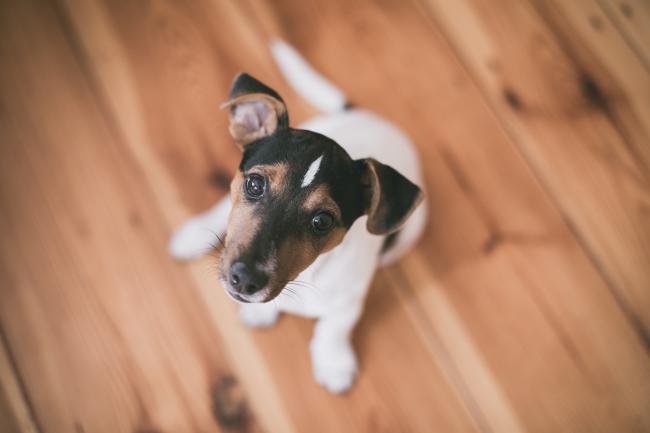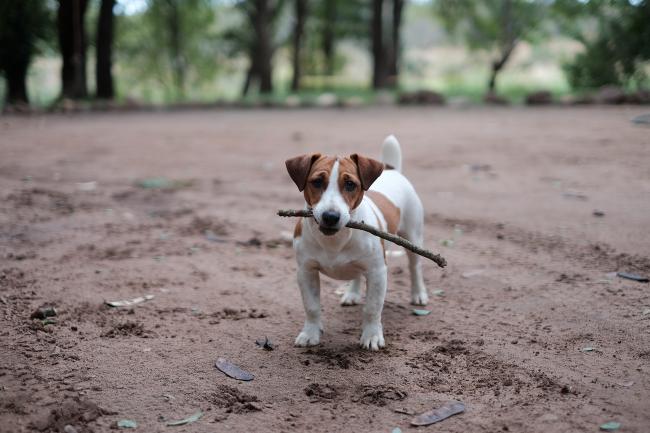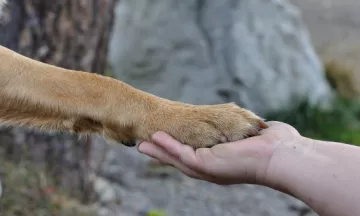Jack Russell Terrier: Breed Spotlight

Fact sheet
- Breed name: Jack Russell Terrier / Jack Russell
- Classification: terrier
- Size: small
- Coat: three types - either smooth, broken or rough
- Colour: white with tan/black patches. Bicolour or tricolour.
- Personality: confident, intelligent, energetic
- Family-friendly: yes, for experienced dog owners and active families with older children
- Friendly with other pets: no
Jack Russell Background
The Jack Russell Terrier is a brave little dynamo with the confidence of a big dog in a small dog's body.
The breed was developed in Devon, England in the 17th Century for the purpose of fox hunting. Consequently, owners should be aware that these hunting instincts are still strong in the breed! This is a spirited dog that needs an experienced hand to match its strong personality and cheeky nature. However, if you have done your research and feel ready to own a Jack Russell, you are in for a fun and entertaining time.
Physical Appearance of the Jack Russell
Jack Russells can vary a bit in size, but generally can be up to 35cm tall. Some have longer legs than others and are known as Parson Jack Russell Terriers in England. Regardless, Jack Russells are always on the smaller size, but don't let their short stature fool you into thinking they are shy and retiring!
There are three coat types known as smooth, broken or rough, which just describe the various lengths and textures. Regardless of texture, its coat is always dense and water-resistant. They are usually mostly white-bodied with tan or black patches on the head, tail, legs and torso. They have long muzzles, folded ears and athletic build designed to run and jump.

Jack Russell Behaviour and Temperament
Jack Russells are born hunters, so will chase just about anything that moves including cats, dogs, cars and even buses. As such, you must always keep your Jack Russell on a leash when out for a walk.
These little dogs are very smart, and will work out how to escape even the most secure backyard. Therefore, it's essential that you have a very escape-proof space for your Jack Russell to live. If not, they will dig, climb or jump their way over just about any barrier.
Furthermore, don't expect your Jack Russell to calm down after they grow into adulthood. This is a mischievous dog that wants to make the most out of life and will run and play from morning to night. Additionally, Jack Russells can be headstrong, so need consistent training from puppyhood.
Training and Exercising Jack Russells
Jack Russell's need about 45 minutes of vigorous exercise every day, otherwise they will leave a path of destruction through your house. Their high energy levels are truly unrivalled. Furthermore, the breed has a strong natural drive to dig, which is something to be aware of if you are planning on bringing home a Jack Russell.
Although a Jack Russell can be taught to come when called, don't ever take risks by removing their leash during a walk. Their desire to chase is far stronger than their desire to please! They are known to confront much larger dogs, moving traffic and other smaller pets, so do be careful when out and about.
Despite this, they are a super smart breed that loves a good mental challenge and thrives with positive reinforcement.
Living with a Jack Russell
Jack Russell's are very vocal, so can make a very good watchdog for your family. However, this tendency to bark means they shouldn't be left alone all day. Likewise, they don't suit apartment living unless they have ample of outside time and stimulation. A pet sitter can help burn some energy during the day if you work full-time.
Jack Russells can be very boisterous and jump up on smaller children when excited. As such, this is a breed that suits older children and very active families.

Jack Russell Health
Jack Russells are a very healthy breed with a low likelihood of genetic illness. They have a long life expectancy, and can even live to the impressive age of 16.
The following health concerns can come up in Jack Russells:
- Skin allergies
- Eye problems, such as progressive retinal atrophy and glaucoma
- Luxating Patella – a common leg problem in small dog breeds
- Leg Calve Perthes Disease - sometimes confused with Hip Dysplasia
- Dental issues
Grooming
Jack Russells are low maintenance when it comes to a grooming routine. They will need a regular to manage normal amounts of shedding, but keep themselves quite clean. As such, they rarely need a bath (unless they roll in something smelly!).
Clip your Jack Russell's claws to prevent them from scratching your legs whilst jumping. Lastly, keep their teeth clean with a doggy toothbrush and dental chews.
Worried about leaving your Jack Russell at home? Prevent separation anxiety by booking a Pawshake sitter. It's super easy – just enter your suburb and start searching today!






